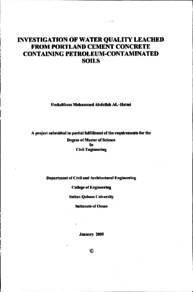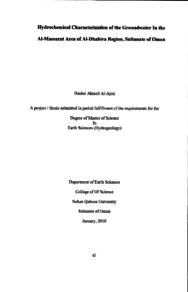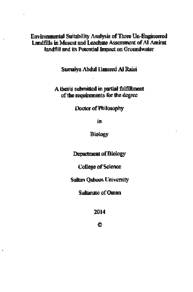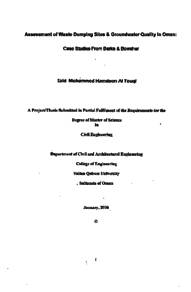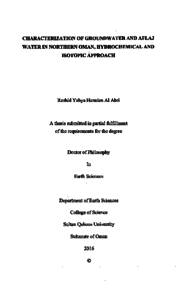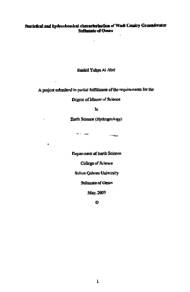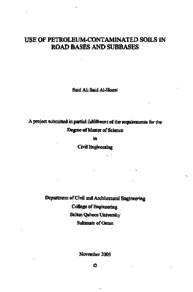Document
Investigation of water quality leached from Portland cement concrete containing petroleum-contaminated soils
Publisher
Sultan Qaboos University
Gregorian
2005
Language
English
English abstract
Petroleum products from leaking underground storage tanks (LUST), from oil spills on clean soils, or from soils surrounding petroleum refineries and crude oil wells could contaminate soil and have the potential to pollute surface and groundwater systems. Removal and proper disposal of petroleum-contaminated soils (PCS) are legally required to prevent further contamination of groundwater. PCS consist of mixtures of natural sands, silts and clays with petroleum products.
In Oman, Petroleum Development Oman (PDO) generates approximately 53,000 tons/year of PCS. This research investigated the potential use of PCS in-lieu of natural sand in Portland cement concrete mixtures. The main thrust of the work is to evaluate whether heavy metals will leach out from concrete containing PCS. Raw materials as well as selected optimum mixtures were evaluated for potential contaminants.
Two types of PCS were investigated (untreated and treated PCS). For each soil type, six mixtures were prepared by replacing sand with PCS (PCS/sand ratios of 0, 5, 10, 15, 20 and 25%, by weight). A slump test was carried out on fresh concrete. For hardened concrete, compressive and flexural strengths tests were conducted at different curing times of 7, 28, 56 and 90 days.
The results indicate that: (1) there is a decrease in compressive and flexural strengths as untreated or treated PCS content increases; (2) for all mixes prepared, the control mixture (0% PCS) yielded the highest compressive and flexural strengths; (3) a target 28-day compressive strength of 30 MPa can be achieved using 25% or less untreated or treated PCS; and (4) treated PCS (less oil content) yielded higher compressive strength results than untreated PCS.
Leachability-based testing of PCS inclusion in Portland cement concrete was conducted using an Inductively Coupled Plasma-Optical Emission Spectrophotometry (ICP). Individual raw materials (untreated PCS, treated PCS, water, Portland cement, sand, and coarse aggregate), fresh concrete mixtures containing PCS/sand ratios of 0, 5, 10, 15, 20 and 25%, by weight and hardened concrete samples obtained at different curing periods of 7, 28, 56 and 90 days were a nalyzed for Silver (Ag), Barium (Ba), Cadmium (Cd), Chromium (Cr), Lead (Pb) and Vanadium (V).
The results indicate that: (1) the Ag, Cd, Cr and Pb concentrations in the concrete mixes containing treated PCS were consistent with that of the control mix; (2) an increase in PCS content increases both the Ba and V concentration in that mix; (3) Ag and Cd concentrations in concrete mixes containing untreated PCS were consistent with those values obtained for the control mix; (4) the concentrations of Ag and Cd in raw materials were consistent with the concentrations of Ag and Cd in concrete mixes containing untreated and treated PCS; (5) the concentration of Ba was higher in raw materials than in concrete mixes prepared using untreated and treated PCS; and (6) the concentrations of Cr and Pb were lower in raw materials than in concrete mixes containing PCS.
Recommendations for further work include conducting durability-based tests such as surface absorption. Furthermore, additional leaching-based tests using the Toxicity Characteristic Leaching Procedure (TCLP) should be conducted to draw a comparison between our results obtained using the Plant Digestion Procedure and those leachability results that could be obtained using TCLP. Such mixes should be also tested for toxic organics concentrations.
Member of
Resource URL
Arabic abstract
المواد البترولية الناتجة عن تسرب الخزانات الأرضية ، وتناثر البترول على سطح التربة النقية ، أو التربة المحيطة بالمصافي النفطية ، وحفر النفط الخام قد تلوث التربة وتؤدي إلى تلويث انظمة المياه السطحية والجوفية . ازالة التربة الملوثة بالبترول والتخلص منها تعتبر ضرورة قانونية لمنع استمرارية تلويث المياه الجوفية ، تتكون التربة الملوثة بالبترول من خليط من الرمال الطبيعة وطمي وطين مع مواد بترولية .
شركة تنمية نفط عمان ( PDO ) في سلطنة عمان تنتج ما يقارب 000ر53 الف طن سنويا من التربة الملوثة بالبترول . هذا البحث يدرس احتمالية استعمال التربة الملوثة بالبترول بدلا من الرمل الطبيعي في الخلطات الخرسانية والهدف الرئيسي من هذه الدراسة هو تقييم مدى ترشح المعادن الثقيلة من الخلطات الخرسانية المحتوية على التربة الملوثة بالبترول . المواد الخام وخلطات مثالية مختارة تم كذلك تقييمها لاحتمالية تلوثها .
نوعين من التربة الملوثة بالبترول تم دراستها ( التربة المعالجة والغير معالجة ) ولكل نوع من التربة تم تحضير ستة خلطات باستبدال جزء من الرمل واستخدام نسب من التربة الملوثة (0، 5، ۱۰ ، ۱۰ ، ۲۰ ، ۲۵ % ). تم إجراء اختبار الهبوط على الخلطة الرطبة . أما بالنسبة للخرسانة فقد تم اجراء اختبار العينات لكل من مقاومة الضغط ومقاومة الثني عند مختلف فترات الإنضاج في الماء (۷ ، ۲۸ ، 56، 90 يوما).
أظهرت النتائج ما يلي :
1) أن هناك انخفاض في مقاومة الضغط والانحناء مع زيادة كمية التربة الملوثة بالبترول سواء المعالجة أو
الغير معالجة.
۲) ولجميع الخلطات المحضرة تعطي خلطة التحكم اكبر نتيجة لشدة مقاومة الضغط والانحناء.
۳) يمكن الحصول على مقاومة الضغط بمقدار ۳۰ ميجا باسكال باستخدام ۲۰ % او اقل من التربة الملوثة
بالبترول سواء المعالجة أو الغير معالجة .
4) تعطي التربة المعالجة نتائج اعلى المقاومة الضغط مقارنة بالتربة الغير معالجة .
تم اختبار ترشيح التربة الملوثة بالبترول المتضمنة في الخلطة الخرسانية عن طريق جهاز يسمى (Inductively Coupled Plasma - Optical Emission Spectrophotometry ) . المواد الخام الأولية التربة الملوثة بالبترول المعالجة والغير معالجة ، الأسمنت ، الرمل ، والحصى ) ، الخلطات الخرسانية الرطبة المحتوية على التربة الملوثة / الرمل بنسب (۰، ۵، ۱۰ ، ۱۰ ، ۲۰، ۲۵ باستخدام الوزن ) وعينات الخرسانة المنتجة عند مختلف فترات الإنضاج (۷، ۲۸ ، 56، 90 يوما ) تم تحليلها لمعرفة تركيز الفضة ، الباريوم ، الكادميوم ، الكروميوم ، الرصاص ، والفانیدیوم . أظهرت النتائج ما يلي :
۱) تركيز الفضة ، الكادميوم ، الكروميوم والرصاص في الخلطات الخرسانية المتضمنة التربة الملوثة
بالبترول المعالجة تتطابق مع تركيزها في خلطة التحكم .
۲) زيادة كمية التربة الملوثة يزيد تركيز كل من الباريوم والفانیدیوم في تلك الخلطة .
۳) تركيز الفضة والكادميوم في الخلطات الخرسانية المتضمنة التربة الملوثة بالبترول الغير معالجة تتطابق
مع تركيزها في خلطة التحكم .
4) تركيز الفضة والكادميوم في المواد الخام الأولية تتوافق مع تركيز الفضة والكادميوم في الخلطات
الخرسانية المتضمنة التربة الملوثة بالبترول المعالجة والغير معالجة .
5) تركيز الباريوم كان اعلى في المواد الخام الأولية من تركيزها في الخلطات الخرسانية المحضرة باستخدام التربة الملوثة بالبترول المعالجة والغير معالجة .
6) تركيز الكروميوم والرصاص كان أقل في المواد الخام الأولية من تركيزها في الخلطات الخرسانية
المتضمنة التربة الملوثة بالبترول .
التوصيات لاعمال إضافية في المستقبل تتضمن القيام باختبارات التحمل مثل فحص امتصاص الأسطح . بالاضافة الى ذلك لابد من القيام باختبارات اضافية للترشيح باستخدام طريقة خاصية الترشيح السامة لعمل مقارنة بين النتائج التي حصلنا عليها بطريقة تحليل النبات والنتائج التي قد نحصل عليها بطريقة خاصية الترشيح السامة . كما أن تلك الخلطات لابد أن تعرض لاختبار تركيز المواد العضوية السامة .
شركة تنمية نفط عمان ( PDO ) في سلطنة عمان تنتج ما يقارب 000ر53 الف طن سنويا من التربة الملوثة بالبترول . هذا البحث يدرس احتمالية استعمال التربة الملوثة بالبترول بدلا من الرمل الطبيعي في الخلطات الخرسانية والهدف الرئيسي من هذه الدراسة هو تقييم مدى ترشح المعادن الثقيلة من الخلطات الخرسانية المحتوية على التربة الملوثة بالبترول . المواد الخام وخلطات مثالية مختارة تم كذلك تقييمها لاحتمالية تلوثها .
نوعين من التربة الملوثة بالبترول تم دراستها ( التربة المعالجة والغير معالجة ) ولكل نوع من التربة تم تحضير ستة خلطات باستبدال جزء من الرمل واستخدام نسب من التربة الملوثة (0، 5، ۱۰ ، ۱۰ ، ۲۰ ، ۲۵ % ). تم إجراء اختبار الهبوط على الخلطة الرطبة . أما بالنسبة للخرسانة فقد تم اجراء اختبار العينات لكل من مقاومة الضغط ومقاومة الثني عند مختلف فترات الإنضاج في الماء (۷ ، ۲۸ ، 56، 90 يوما).
أظهرت النتائج ما يلي :
1) أن هناك انخفاض في مقاومة الضغط والانحناء مع زيادة كمية التربة الملوثة بالبترول سواء المعالجة أو
الغير معالجة.
۲) ولجميع الخلطات المحضرة تعطي خلطة التحكم اكبر نتيجة لشدة مقاومة الضغط والانحناء.
۳) يمكن الحصول على مقاومة الضغط بمقدار ۳۰ ميجا باسكال باستخدام ۲۰ % او اقل من التربة الملوثة
بالبترول سواء المعالجة أو الغير معالجة .
4) تعطي التربة المعالجة نتائج اعلى المقاومة الضغط مقارنة بالتربة الغير معالجة .
تم اختبار ترشيح التربة الملوثة بالبترول المتضمنة في الخلطة الخرسانية عن طريق جهاز يسمى (Inductively Coupled Plasma - Optical Emission Spectrophotometry ) . المواد الخام الأولية التربة الملوثة بالبترول المعالجة والغير معالجة ، الأسمنت ، الرمل ، والحصى ) ، الخلطات الخرسانية الرطبة المحتوية على التربة الملوثة / الرمل بنسب (۰، ۵، ۱۰ ، ۱۰ ، ۲۰، ۲۵ باستخدام الوزن ) وعينات الخرسانة المنتجة عند مختلف فترات الإنضاج (۷، ۲۸ ، 56، 90 يوما ) تم تحليلها لمعرفة تركيز الفضة ، الباريوم ، الكادميوم ، الكروميوم ، الرصاص ، والفانیدیوم . أظهرت النتائج ما يلي :
۱) تركيز الفضة ، الكادميوم ، الكروميوم والرصاص في الخلطات الخرسانية المتضمنة التربة الملوثة
بالبترول المعالجة تتطابق مع تركيزها في خلطة التحكم .
۲) زيادة كمية التربة الملوثة يزيد تركيز كل من الباريوم والفانیدیوم في تلك الخلطة .
۳) تركيز الفضة والكادميوم في الخلطات الخرسانية المتضمنة التربة الملوثة بالبترول الغير معالجة تتطابق
مع تركيزها في خلطة التحكم .
4) تركيز الفضة والكادميوم في المواد الخام الأولية تتوافق مع تركيز الفضة والكادميوم في الخلطات
الخرسانية المتضمنة التربة الملوثة بالبترول المعالجة والغير معالجة .
5) تركيز الباريوم كان اعلى في المواد الخام الأولية من تركيزها في الخلطات الخرسانية المحضرة باستخدام التربة الملوثة بالبترول المعالجة والغير معالجة .
6) تركيز الكروميوم والرصاص كان أقل في المواد الخام الأولية من تركيزها في الخلطات الخرسانية
المتضمنة التربة الملوثة بالبترول .
التوصيات لاعمال إضافية في المستقبل تتضمن القيام باختبارات التحمل مثل فحص امتصاص الأسطح . بالاضافة الى ذلك لابد من القيام باختبارات اضافية للترشيح باستخدام طريقة خاصية الترشيح السامة لعمل مقارنة بين النتائج التي حصلنا عليها بطريقة تحليل النبات والنتائج التي قد نحصل عليها بطريقة خاصية الترشيح السامة . كما أن تلك الخلطات لابد أن تعرض لاختبار تركيز المواد العضوية السامة .
Category
Theses and Dissertations

